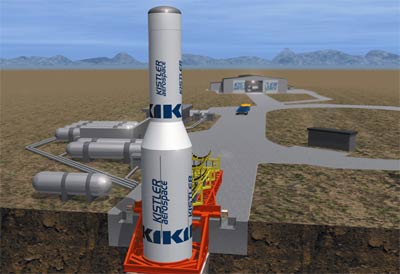The state of the RLV industry, 2007 (part one)by Taylor Dinerman
|
| The military needs for reliable low-cost access to space are growing and, while the technology may not be as ready as some may wish, the requirement is not going away. |
The Air Force has a small program, called Fully-Reusable Access to Space Technologies (FAST), that could be scaleable to a genuine two stage to orbit system, but the funding is small and the funding for the Falcon program is equally inadequate. The Marine Corps wants eventually to have its Small Unit Space Transport and Insertion Capability (SUSTAIN) vehicle that will, when ready, deploy a squad of Marines anywhere in the world within two hours, in order to carry out raids or to rescue, resupply, or reinforce American operations or facilities that may be in extreme danger (see “Low-cost access to orbit: space Marines to the rescue”, The Space Review, January 9, 2006). However, that project will not see the light of day until 2035 at the earliest.
The military needs for reliable low-cost access to space are growing and, while the technology may not be as ready as some may wish, the requirement is not going away. The Chinese ASAT test in January of this year means that without the capability to quickly replenish satellite constellations, the advantages the US derives from its space assets are at risk. The Operationally Responsive Space office just established at Kirtland Air Force Base in New Mexico is moving in the right direction with the Falcon program, but that is only part of the answer. The USAF must enlist other services and agencies in a broad program focused on solving the most urgent technology needs of the RLV industry, especially materials.
NASA has, in the shape of the Commercial Orbital Transportation Services (COTS) efforts, opened a door that may—and the word “may” should be stressed—lead to a revolution in the way the agency does business. The question that NASA is facing is simple: why shouldn’t they simply buy seats on rockets to low Earth orbit (LEO) the way they buy seats on commercial aircraft that fly between Houston and Washington? The agency might answer that, in the long run, they do not want to depend on Russia or on any other foreign supplier for US human access to space. COTS supports American companies that are trying to build a business, supplying access for astronauts and others to LEO. Elon Musk’s SpaceX is well known and their project using the Dragon capsule design is moving ahead quite nicely.
Rocketplane Kistler (RpK), the other winner of a funded COTS award, is moving slower, and they are having difficulty raising private money to complete their K-1 vehicle. They do have a lot of the hardware already built and have thoroughly tested their engines and some other components. One company spokesman said that they have already spent about $600 million on their vehicle and need about another $600 million to complete the project. This means that they will need about $400 million in private investment in order to become fully operational.
| The best news of all, though, is that the RLV industry is acting as just that, an industry, not a community of dreamers and promoters. |
While some at NASA are growing impatient waiting for RpK to raise the money, it has been pointed out that no one has ever raised any serious capital in the summertime. The good news is that the company does have a very serious and well regarded investment advisor who would not have gotten involved if they didn’t think that they could made the case to potential equity investors. Raising money is an expensive and time-consuming process and NASA’s involvement as an “investor” with an unusual status is probably not helping things.
The K-1 vehicle, when ready, will be able to deliver satellites, pressurized and unpressurized cargo, and eventually passengers to LEO, making it a true, multipurpose space transportation system. As long as the company does not get too far ahead of itself they should do fine. There is every reason to think that they have a business plan, built around COTS, that is realistic and will be profitable within a reasonable time frame.
The commercial suborbital space tourism business growing faster than anyone could have imagined three years ago after the success of SpaceShipOne. Alex Tai of Virgin Galactic welcomed the EADS space tourism project as adding to the competitive environment. Other suborbital projects including Jeff Bezos’s Blue Origin vehicle are moving from paper and pixels to prototype hardware and eventually to operational status.
The best news of all, though, is that the RLV industry is acting as just that, an industry, not a community of dreamers and promoters.
